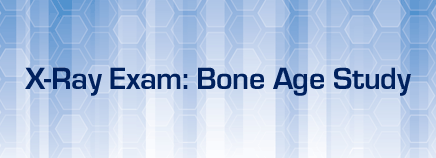
What It Is
A bone age study helps doctors estimate the maturity of a child’s skeletal system. It’s usually done by taking a single X-ray of the left wrist, hand, and fingers. It is a safe and painless procedure that uses a small amount of radiation. The bones on the X-ray image are compared with X-rays images in a standard atlas of bone development, which is based on data from large numbers of other kids of the same gender and age. The bone age is measured in years.
A child’s bones, such as those in the fingers and wrist, contain “growing zones” at both ends called growth plates. These plates consist of special cells responsible for the bones’ growth in length. Growth plates are easy to spot on an X-ray because they’re softer and contain less mineral, making them appear darker on an X-ray image than the rest of the bone.
As kids grow, growth plates change in appearance on the X-ray images and become thinner, eventually disappearing (this is what is called “closed growth plates”). Because they look different at each age, a doctor can assign a bone age based on the appearance of the bones and growth plates. A child’s bone age (also called the skeletal age) is assigned by determining which of the standard X-ray images in the atlas most closely match the appearance of the child’s bones on the X-ray.
A difference between a child’s bone age and his or her chronological age might indicate a growth problem. But such differences don’t always mean there’s a problem, because perfectly healthy kids can have bone ages that differ from their chronological ages.
Why It’s Done
The bone age study can help evaluate how fast or slowly a child’s skeleton is maturing, which can help doctors diagnose conditions that delay or accelerate physical growth and development. This test is usually ordered by pediatricians or pediatric endocrinologists.
Bone age can be used to predict:
- how much time a child will be growing
- when a child will enter puberty
- what the child’s ultimate height will be
The test is also used to monitor progress and guide treatment of kids with conditions that affect growth, including:
- diseases that affect the levels of hormones involved in growth, such as growth hormone deficiency, hypothyroidism, precocious puberty, and adrenal gland disorders
- genetic growth disorders, such as Turner syndrome (TS)
- orthopedic or orthodontic problems in which the timing and type of treatment (surgery, bracing, etc.) must be guided by the child’s predicted growth
Preparation
A bone age X-ray will be done by an X-ray technician in a radiology department within a hospital, a freestanding radiology center, or doctor’s office. A bone age X-ray doesn’t require special preparation. Your child will be asked to remove all clothing and jewelry from the area that will be on the X-ray because they can interfere with the image.
Developing babies are more sensitive to radiation and are at more risk for harm, so if your daughter is pregnant, be sure to tell her doctor and the X-ray technician.
Procedure
This is a quick procedure. It takes only a few minutes from start to finish, and actual exposure to radiation is often less than a few seconds.
Your child will be asked to enter a special room that will most likely contain a table and a large X-ray machine hanging from the ceiling. Parents are usually able to accompany their child to provide reassurance and support. If you stay in the room while the X-ray is being done, you’ll be asked to wear a lead apron to protect certain parts of your body from radiation.
The technician will ask your child to sit on a stool and place his or her left hand on the table with fingers spread. A protective shield will be given to your child as well. The technician will then step behind a wall or into an adjoining room to operate the machine. Your child will be asked to stay still for a couple of seconds while the X-ray is taken. This is important to prevent blurring of the X-ray image.
What to Expect
Your child won’t feel anything as the X-ray is taken. The X-ray room may feel cool, due to the air conditioning used to maintain the equipment.
After the X-ray is taken, you and your child will be asked to wait a few minutes while the images are processed. If they’re blurred, the X-ray may need to be redone.
Getting the Results
The X-ray will be looked at by a radiologist (a doctor who’s specially trained in reading and interpreting X-ray images). The radiologist will send a report to your doctor, who will discuss the results with you and explain what they mean.
Risks
In general, X-rays are very safe. Although any exposure to radiation poses some risk to the body, the amount used in a bone age study is small and not considered dangerous. It’s important to know that radiologists use the minimum amount of radiation required to get the best results.
Developing babies are more sensitive to radiation and are at more risk for harm, so if your daughter is pregnant, be sure to tell her doctor and the X-ray technician.
Helping Your Child
You can help your child prepare for a bone age study by explaining the test in simple terms before the procedure. It may help to explain that getting an X-ray is like posing for a picture. You can describe the room and the equipment that will be used and reassure your child that you’ll be right there for support. Be sure to explain the importance of keeping still while the X-ray is taken so it won’t have to be repeated.
If You Have Questions
If you have questions about why the bone age study is needed, speak with your doctor. You can also talk to the X-ray technician before the procedure.

